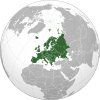保加利亞經濟
外观
 索菲亞金融區 | |
| 货币 | 保加利亞列弗 (BGN) |
|---|---|
| 财政年度 | 歷年 |
贸易组织 | 歐盟、世界貿易組織、黑海經濟合作組織 |
国家分组 |
|
| 统计数据 | |
| 人口 | ▼ 7,000,039 (1 January 2019)[3] |
| GDP | |
GDP增长率 |
|
人均GDP | |
各产业GDP | |
| ▼ 39.6 中 (2018;歐洲統計局)[11] | |
劳动力 | |
各产业劳动力 |
|
| 失业率 | |
平均工资毛额 | BGN 1,247 / €637 / $714 每月 (2019年3月) |
| BGN 968 / €495 / $555 每月 (2019年3月) | |
主要产业 | 電,煤氣,水;食品,飲料,煙草;機械設備,汽車零部件,賤金屬,化工產品,焦炭,精煉石油,核燃料;外包中心 |
| ▼ 第61位 (容易, 2020年)[19] | |
| 对外贸易 | |
| 出口 | ▲ $333.14 億 (2018年)[20] |
出口商品 | 服裝,鞋類,鋼鐵,機械設備,燃料,農業,煙草,IT組件 |
主要出口伙伴 | |
| 进口 | ▲ $362.90 億 (2018年)[22] |
进口商品 | 機械工具;金屬礦石;化學品塑料;燃料,礦物和原材料 |
主要进口伙伴 | |
外商直接投資存量 | |
| ▲ $25.62 億 (2017年估計)[16] | |
外债总额 | ▲ $420.6 億 (2017年估計)[16] |
| 公共财政 | |
| 收入 | 佔GDP 38.3% (2018年)[24] |
| 支出 | 佔GDP 36.5% (2018年)[24] |
| 经济援助 | $475 million (2004-06) |
| ▲ $28.38 billion (31 December 2017 est.)[16] | |


保加利亚经济在1989年与苏联的经济联系失落後受到巨大打击。人民生活条件下降40%。联合国对南斯拉夫和伊拉克的经济制裁给保加利亚也带来了冲击。1994年经济开始得到恢复,但由于不充足的经济改革和不稳定的银行系统,1996年经济再次垮台。从1997年起经济得到恢复。2003年人民生活水平有望恢复到1990年代前的水平。
保加利亚传统上是一个农业国,玫瑰、酸奶和葡萄酒历来在国际市场上享有盛名。工业目前以食品加工业和纺织业为主,旅游业近年来也有所发展。保加利亚是中欧自由贸易协定组织的成员。
货币政策
[编辑]因为1996-1997年保加利亚经济危机,保加利亚货币列弗兑美元汇率从77:1(1996年年中)剧贬到3000:1(1997年年初),年通涨率从310.8%(1996年底)飆升到2047%(1997年3月),国内生产总值下降了10.1%。
1997年5月保加利亚接受国际货币基金组织的条件,7月1日,保加利亚中央银行实行联系汇率制列弗与德国马克挂钩:1000列弗兑1德国马克。银行利率由160%(4月)降到6%(10月),实现了金融稳定。目前保加利亚的联系汇率制是1.95583列弗兑1欧元。
參考資料
[编辑]- ^ World Economic Outlook Database, April 2019. IMF.org. International Monetary Fund. [29 September 2019]. (原始内容存档于2019-12-22).
- ^ World Bank Country and Lending Groups. datahelpdesk.worldbank.org. World Bank. [29 September 2019]. (原始内容存档于2019-10-28).
- ^ Population on 1 January. ec.europa.eu/eurostat. Eurostat. [16 August 2019]. (原始内容存档于2020-02-05).
- ^ 4.0 4.1 4.2 4.3 4.4 4.5 4.6 World Economic Outlook Database, October 2019. IMF.org. International Monetary Fund. [15 October 2019]. (原始内容存档于2020-07-30).
- ^ Global Economic Prospects, January 2020 : Slow Growth, Policy Challenges (PDF). openknowledge.worldbank.org. World Bank: 83. [11 January 2020]. (原始内容存档 (PDF)于2020-02-09).
- ^ Gross Domestic Product for the Second Quarter of 2017 (Flash Estimates) | National statistical institute. National Statistical Institiute. [2017-09-03]. (原始内容存档于2020-08-04).
- ^ Индикатори за бедност и социално включване общо за страната. National Statistical Institiute. [2016-05-10]. (原始内容存档于2016-06-03) (保加利亚语).
- ^ Poverty headcount ratio at national poverty lines (% of population) - Bulgaria. data.worldbank.org. World Bank. [23 October 2019]. (原始内容存档于2019-05-14).
- ^ People at risk of poverty or social exclusion. ec.europa.eu. Eurostat. [8 May 2019]. (原始内容存档于2020-11-11).
- ^ Poverty headcount ratio at $5.50 a day (2011 PPP) (% of population) - Bulgaria. data.worldbank.org. World Bank. [6 October 2019]. (原始内容存档于2020-08-20).
- ^ Gini coefficient of equivalised disposable income - EU-SILC survey. ec.europa.eu. Eurostat. [8 May 2019]. (原始内容存档于2020-04-08).
- ^ Human Development Index (HDI). hdr.undp.org. HDRO (Human Development Report Office) United Nations Development Programme. [11 December 2019]. (原始内容存档于2016-06-27).
- ^ Inequality-adjusted Human Development Index (IHDI). hdr.undp.org. HDRO (Human Development Report Office) United Nations Development Programme. [11 December 2019]. (原始内容存档于2019-12-11).
- ^ Labor force, total - Bulgaria. data.worldbank.org. World Bank. [1 November 2019]. (原始内容存档于2020-08-20).
- ^ Employment rate by sex, age group 20-64. ec.europa.eu/eurostat. Eurostat. [24 August 2019]. (原始内容存档于2019-10-19).
- ^ 16.0 16.1 16.2 16.3 16.4 16.5 The World Factbook. CIA.gov. Central Intelligence Agency. [13 March 2019]. (原始内容存档于2020-11-12).
- ^ Unemployment by sex and age - monthly average. appsso.eurostat.ec.europa.eu. Eurostat. [31 January 2020]. (原始内容存档于2020-02-23).
- ^ Youth unemployment rate by sex, age (15-24) and country of birth. appsso.eurostat.ec.europa.eu. Eurostat. [26 December 2019]. (原始内容存档于2020-11-04).
- ^ Doing Business in Bulgaria. World Bank. [21 November 2017]. (原始内容存档于2016-08-11).
- ^ Bulgaria Export Sales 2018. World's Top Exports. 2018 [2020-02-01]. (原始内容存档于2020-02-01).
- ^ Export Partners of Bulgaria. The Observatory of Economic Complexity. 2017 [2019-03-31]. (原始内容存档于2017-09-20).
- ^ Bulgaria Import Sales 2018. Wikipedia. 2018 [2020-02-01]. (原始内容存档于2020-01-23).
- ^ Import Partners of Bulgaria. The Observatory of Economic Complexity. 2017 [2019-03-31]. (原始内容存档于2017-09-20).
- ^ 24.0 24.1 24.2 24.3 24.4 24.5 Euro area government deficit at 0.5% and EU28 at 0.7% of GDP (PDF). ec.europa.eu/eurostat. Eurostat. [6 February 2020]. (原始内容存档 (PDF)于2019-10-21).
- ^ Bulgaria’s Credit Rating Raised by S&P on Fiscal Performance. Bloomberg. [30 November 2019]. (原始内容存档于2020-11-26).
- ^ Scope upgrades Bulgaria's long-term credit rating to BBB+, and revises the Outlook to Stable. Scope Ratings. [22 February 2019]. (原始内容存档于2013-03-28).
| ||||||||||||

